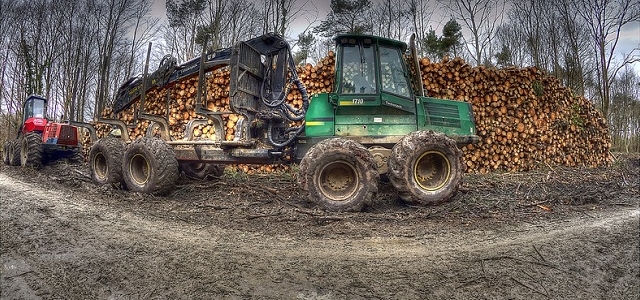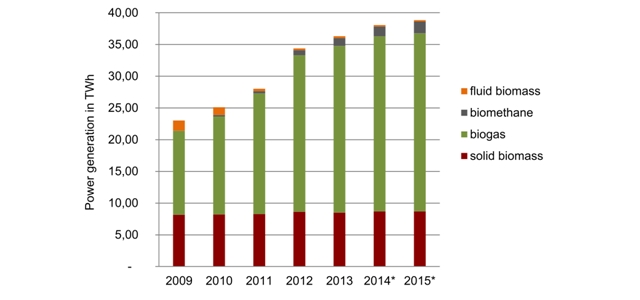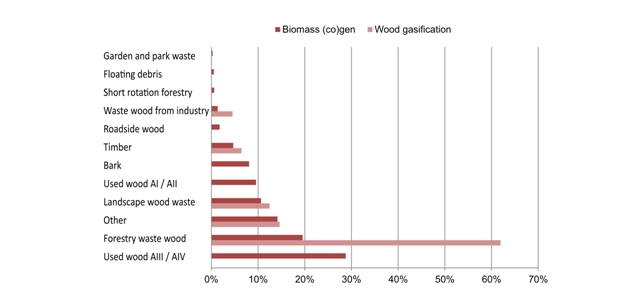Charges that Germany is cutting down its own and possibly the world’s forests for its Energiewende continue to crop up. But it turns out that the amount used to generate power is small – and almost all of it seems to be waste recovery. Craig Morris looks into the issue.

It is important to differentiate between waste wood and fresh timber. (Photo by Dan Hogben, modified, CC BY 2.0)
In a recent tweet, Mike Shellenberger of the Breakthrough Institute (BTI) made the erroneous claim that “Germany pulps & burns forests for electricity production.” With reference to my previous article on how Germany uses wood pellets, I pointed out to him that the amount of wood used to generate power is apparently close to zero percent. But how much wood is used for power plants in Germany exactly?
Wood is used in cogeneration units, but the official data does not even list wood pellets as a power source. The German Industry Ministry’s overview (see slide 6 of this PDF in German) has nearly 12 TWh (two percent of total power generation) from “solid biomass,” but that figure includes such things as sewage sludge – our first indication that Germany focuses on waste.
In a study published in May by the German Biomass Research Center (PDF in German), we find the following chart (my translation):

Source: DBFZ
Here, we see that solid biomass without sewage waste comes in at around 8 TWh, or roughly 1.3 percent of German power generation. Note as well that the level fluctuates, but it has not grown in the past six years. Furthermore, most of that solid biomass seems to be recovered waste. For instance, a project in Murrhardt uses “wood chips from local sources,” a waste product from the timber sector, in cogeneration units (report in German). Another one near Hamburg uses “waste wood” (Altholz), but only for heat (report in German). Specifically, waste wood – or Altholz – is wood products that have already been used for other purposes, such as furniture. How much of that solid biomass is fresh timber from forests and not waste products that are being recovered (the latter being a good idea)?
Even with a translation, the chart above is cryptic. The labels A1 to A4 are explained in the German Wikipedia entry for Altholz. Roughly, A1 is untreated waste wood, with A4 being waste wood with the most chemical treatment. Otherwise, most entries in the chart above show that the wood is recovered from some other process. The only exceptions are “timber” and “short rotation forestry,” which collectively make up close to five percent of the total. Five percent of 1.3 comes out to be 0.07 percent – that’s how much of German electricity comes from fresh timber.
When contacted for this report, Jan Schlaffke of the German Pellets Institute (DEPI) confirmed that “pellets in Germany are made almost exclusively out of waste wood from sawmills.” The total amount of power generated from pellets, he said, was 0.087 TWh in 2014, meaning that Germany gets 0.0001 percent of its electricity from wood pellets, almost all of it recovered waste. If you are looking for countries that burn wood pellets from fresh wood, look to Belgium and the UK.
Germany produces heat from waste wood, which is preferable because the process is so much more efficient, including in cogeneration plants. Otherwise, keep in mind that even the growth of biogas from energy crops shown in the first chart above is over, precisely because the German public became concerned about the environmental impact. In 2014, the number of biogas units increased by only three percent, much of which use waste and manure as feedstock – a trend that has continued in 2015 (report in German). Clearly, Germany is not burning its own forests or anyone else’s for energy, much less electricity. In fact, a third of Germany is forest today, and that area is growing.
Craig Morris (@PPchef) is the lead author of German Energy Transition. He directs Petite Planète and writes every workday for Renewables International.

Swiss atom power supposed to be replaced by timber fuel:
http://www.srf.ch/news/schweiz/beznau-liefert-zurzeit-weder-strom-noch-waerme
(last paragraph)
The Swiss Beznau atom power plant’s reactor pressure vessel is cracked.
So it was switched-off, the district heating system (formerly supplied with waste heat from the atom power plant) relies now on 30 year old oil boilers.
But Switzerland is running now out of oil, the strategic reserves are released:
http://www.energynewsmagazine.at/de/schweiz+zapft+notreserve+f%C3%BCr+benzin+und+diesel+an_n7367
Reason given: the river Rhein was always used in the past to transport oil to Switzerland. But the river is drying up, the oil tankers are stucked.
The retreat of glaciers feeding the river during summer time in combination with a summer drought has reduced the water level. Hence no oil is coming up the river, no matter how cheap it is in Rotterdam.
Imagine it gets very cold this winter, the trickle would freeze. Would freeze faster than ever because more and more retired (atom) power plants feed less and less thermal energy into the river.
Germany had plenty of PV and wind power installed in the past, Switzerland was very lazy concerning REs.
How Switzerland would now import the timber to replace the atom – by means of river boats or with electric trains – is a mystery still to be solved …..
[…] about biomass, perhaps because some nuclear proponents there like to misrepresent all biomass as pristine American forests. Not surprisingly, the main scenario for a 100% renewable America has no biomass at all in it. […]